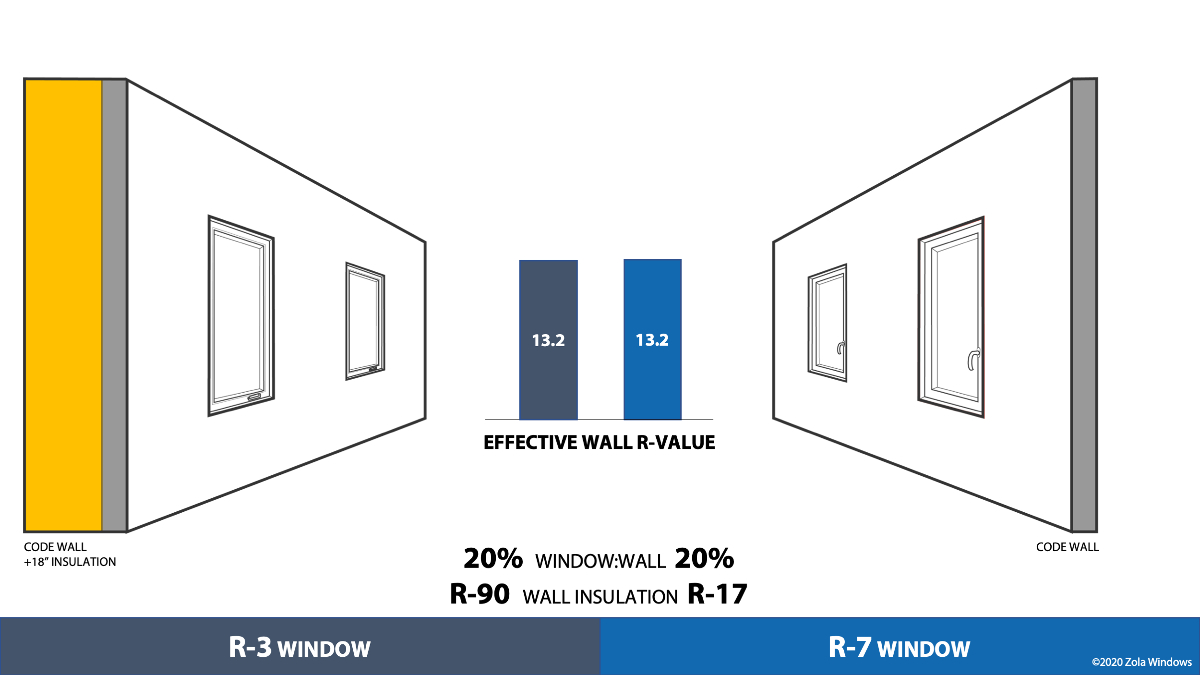Sign up for daily news updates from CleanTechnica on email. Or follow us on Google News!
Recently, we published a story about how to decarbonize your life in 2024. One of the suggestions is to increase the insulating power of exterior walls and roofs but Zola Windows, in a blog post reprinted by Passive House News, points out that windows are often the weakest link in any insulation program. In fact, the wrong units can negate any improvements made to the exterior of a building.”Bad windows will ruin the best wall assemblies,” the company says.
In the old days, a single pane of glass in a wooden frame might have an R value of 1, which is equivalent to virtually no insulating power at all. (R value is a measure of how well a material resists the flow of heat.) Almost any window today has two panes of glass that trap a layer of air between them. The air acts as an insulator, giving it an R value of 3.
To do better, the thickness of the air gap needs to increase, while the frame and the sash also need to be designed and installed to eliminate drafts. Better double pane units today have an R-7 rating and cost just a bit more than standard products. Triple glazed products with high performance sash materials can have an R value of 13, which is about as much as a standard 2×4 inch wall with 3½ inches of fiberglass insulation.
The Weak Link In Any Wall
The thermal performance of your building’s walls is only as strong as the weakest link, and windows are too often that link. Even if you’ve gone to great lengths to build a super-insulated high performance wall, if you poke that wall full of holes then plug those holes with mediocre windows, you will get a wall with poor energy efficiency. Conversely, good windows can make run-of-the-mill walls good and good wall assemblies great, Zola says.
To illustrate the point, they worked with building science expert Skylar Swinford to develop a series of scenarios for an exterior wall in a typical multifamily building unit. The results showed that a high performance window allows more glass area in an exterior wall without a loss of insulating power while a window that performs poorly can undermine the insulating power of an otherwise high performance wall.
In all cases, the exterior wall met current building code standards will some had the benefit of an extra layer of external insulation. In Scenario 1, with windows making up just 10 percent of the exterior wall surface area, the overall insulating power of the wall was a full point higher with high performing windows — R 14. vs R 13.8 — even though the wall with the lesser windows had a higher R rating.

But what if you want more of that great view outside? Here the advantage of high performance windows really stands out. In our mythical home, a wall could have a window to wall ratio of 60 percent and have the same insulating value as a wall built with lesser quality windows just one third the size. Three times more window area, same insulating value when both exterior walls have an R rating of 23. Amazing!

The Effect Of Better Wall Insulation On Energy Efficient Windows
Next, Zola Window and Skylar Swinford modeled what would happen if both exterior walls had an R value of 23. In many places, building codes now mandate 2×6 exterior walls specifically because they have a higher R value, which makes them more energy efficient. In that case, the benefit of using high efficiency windows becomes even more apparent. With a window to wall ratio of 20%, the better windows result in an effective R value for the wall of 15.8 — almost 40% higher than the same wall with low performing windows.

In fact, to construct a wall that rivals the performance of a 2×4 R-17 wall with 20 percent of its surface area comprised of high performance windows, a standard wall with low performance windows would need to add 18 inches of insulation. That’s incredible!

Zola says, “For us, R-7 is run of the mill. We have lots of window lines at that performance level or higher, available in any of our frame materials. At the highest end of the spectrum, our Zola Arctic line products perform at an industry leading R-11 and are currently being used in a research station in Antarctica. For the typical multifamily building or budget conscious single family home in North America, we have several μPVC options that deliver R-7 and R-8 performance at a price point that is competitive with many lower-performing domestic windows.”
The Takeaway
Do high performance windows cost more than standard windows? Probably, but you get what you pay for. In this case, your home will need less heating and cooling over its entire lifetime. That can add up to tens of thousands of dollars in savings over time. In addition, energy efficient windows may also qualify for federal tax credits, which will likely lower the upfront cost to less than the cost of ordinary windows.
If you live in a normal home, upgrading your windows may be the best investment you can make, saving you more money than swapping your furnace for a heat pump or installing solar panels on your roof. That’s a powerful incentive to make replacing your windows a higher priority on your list of home improvements for this year. It’s hard to imagine a better investment, one that will make your home comfortably warm or cool all year round while saving you money.
If you are serious about lowering your carbon footprint, high efficiency windows are one way to do it quickly and easily. Replacing windows involves a lot less fuss than changing over from a furnace to a heat pump, for example. Just be sure to select a reputable contractor and verify the windows going into your home are rated R-7 or higher. After the work is done, you can relax in comfort while you decide what’s next on your home improvement wish list.
Have a tip for CleanTechnica? Want to advertise? Want to suggest a guest for our CleanTech Talk podcast? Contact us here.
Our Latest EVObsession Video
I don’t like paywalls. You don’t like paywalls. Who likes paywalls? Here at CleanTechnica, we implemented a limited paywall for a while, but it always felt wrong — and it was always tough to decide what we should put behind there. In theory, your most exclusive and best content goes behind a paywall. But then fewer people read it!! So, we’ve decided to completely nix paywalls here at CleanTechnica. But…
Thank you!
CleanTechnica uses affiliate links. See our policy here.




